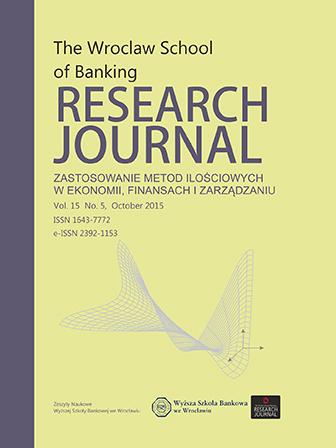Dynamika modelu Solowa i modelu Mankiwa-Romera-Weila z endogenicznymi stopami oszczędności
DOI:
https://doi.org/10.29015/cerem.197Słowa kluczowe:
wzrost gospodarczy, model Solowa, model Mankiwa-Romera-Weila, bifurkacje, chaos deterministyczny, zmienne stopy oszczędności, wykładnik Lapunowa, warunki równowagiAbstrakt
Celem niniejszego opracowania jest analiza własności i dynamiki modelu wzrostu gospodarczego z endogeniczną stopą oszczędności. Punktem wyjścia do rozważań są dyskretne wersje neoklasycznego modelu wzrostu Solowa oraz rozszerzonego modelu Solowa. Okazuje się, że modyfikacja w postaci zmiennych stóp oszczędności zależnych od parametru o charakterze behawioralnym ma znaczny wpływ na dynamikę układu, czyniąc ją bardziej różnorodną. Pojawiają się rozwiązania okresowe, quasi-okresowe oraz chaos deterministyczny. Prognozowanie w długim okresie staje się mocno ograniczone.Bibliografia
Bernanke B.S., Gurkaynak R.S. (2001), Is Growth Exogenous? Taking Mankiw, Romer and Weil Seriously”, „NBER Working Paper” No. 8365.
Day R.H. (1982), Irregular Growth Cycles, „The American Economic Review”, Vol. 72, No. 3, pp. 406–414.
Domański S.R. (1993), Kapitał ludzki i wzrost gospodarczy, Warszawa, PWN.
Dowrick S., Rogers M. (2002), Classical and Technological Convergence: Beyond the Solow-Swan Growth Model, „Oxford Economic Papers”, Vol. 54, No. 3, pp. 369–385.
Ertur C., Koch W. (2007), Growth, Technological Interdependence and Spatial Externalities: Theory and Evidence, „Journal of Applied Econometrics, Vol. 22, No. 6, pp. 1033–1062.
Hommes C.H. (1991), Adaptive learning and roads to chaos. The case of the cobweb model, „Economic Letters”, 36.
Hommes C.H. (1993), Periodic, almost periodic and chaotic behaviour in Hicks’ non-linear trade cycle model, „Economics Letters”, 41.
Hommes C.H. (1995), A reconsideration of Hicks’ non-linear trade cycle model, „Structural Change and Economic Dynamics”, 6.
Jakimowicz A. (2011), Dynamika nieliniowa w badaniach ekonomicznych, „Didactics of mathematics” No. 8 (12).
Kaldor N. (1957), A Model of Economic Growth, „The Economic Journal”, Vol. 67, No 268, pp. 591–624.
Kruszewski R. (2006), O pewnym modelu wzrostu gospodarczego z kapitałem ludzkim i endogenicznym postępie wiedzy, „Problemy wzrostu gospodarczego we współczesnych gospodarkach”, red. D. Kopycińska, Szczecin Uniwersytet Szczeciński, s. 18–24.
Kruszewski R. (2006), Growth model with human capital. Complex economic dynamics, „Modeling Economies in Transition”, red. Władysław Welfe, Piotr Wdowinski, Łódź, AMFET, s. 63–74.
Lee K., Pesaran M.H., Smith R. (1997), Growth and Convergence in a Multi-Country Empirical Stochastic Solow. „Journal of Applied Econometrics, Vol. 12, No. 4, pp. 357–392.
Lines M. (2007), Bifurcation scenarios in a heterogeneous agent, multiplier accelerator model, „Pure Mathematics and Applications”, 16.
Lines M., Westerhoff F. (2010), Infation expectations and macroeconomic dynamics: The case of rational versus extrapolative expectations, „Journal of Economic Dynamics and Control”, 34.
Lorenz H.W. (1987), Goodwin’s nonlinear accelerator and chaotic motion, „Journal of Economics”, 47.
Malaga K. (2009), O niektórych dylematach teorii wzrostu gospodarczego i ekonomii, Warszawa, ZK Polskie Towarzystwo Ekonomiczne.
Mankiw N. Gregory, David Romer, David N. Weil (1992), A Contribution to the Empirics of Economic Growth, „Quarterly Journal of Economics”, 107, pp. 407–437.
Masanjala W.H., Papageorgiou C. (2004), The Solow Model with CES Technology: Nonlinearities and Parameter Heterogeneity, „Journal of Applied Econometrics”, Vol. 19, No. 2, pp. 171–201.
Medio A., Lines M. (2001), Nonlinear Dynamics: a Primer, Cambridge, Cambridge University Press.
Nonneman W., Vanhoudt P. (1996), A Further Augmentation of the Solow Model and the Empirics of Economic Growth for OECD Countries, „The Quarterly Journal of Economics”, Vol. 111, No. 3, pp. 943–953.
Telega I. (2012), Trwałość w modelu wzrostu Solowa. Analiza krytyczna, „Zeszyty Naukowe Nr 12”, Kraków, Polskie Towarzystwo Ekonomiczne.
Tokarski T. (2007), Optymalne stopy inwestycji w N-kapitałowym modelu wzrostu gospodarczego, „Gospodarka Narodowa”, Nr 9.
Westerhoff H. (2006), Nonlinear expectation formation, endogenous business cycles and stylized facto, „Studies in Nonlinear Dynamics and Econometrics”, 10, Issue 4, Article 4.
Woźniak M.G. (2005), Znaczenie kapitału ludzkiego w skracaniu dystansu rozwojowego gospodarki Polski, „Zeszyty Naukowe Nr 3”, Kraków, Polskie Towarzystwo Ekonomiczne.
Pobrania
Numer
Dział
Licencja
Autor przenosi nieodpłatnie na Wyższą Szkołę Bankową we Wrocławiu , bez ograniczeń terytorialnych, majątkowe prawa autorskie do tego utworu w rozumieniu ustawy z dnia 4 lutego 1994 roku o prawie autorskim i prawach pokrewnych ( Dz.U. 1994, Nr 24, poz. 83 ze zm. )na zasadzie wyłączności, tj. prawo do:
a) wyłącznego używania i wykorzystania utworu w dowolnej działalności przez Wyższą Szkołę Bankową we Wrocławiu, w szczególności w działalność Biblioteki Cyfrowej uruchomionej przez Wyższą Szkołę Bankową we Wrocławiu
b) wytwarzania, utrwalania i zwielokrotniania egzemplarzy utworów wszelkimi technikami, w tym techniką drukarską, reprograficzną, zapisu magnetycznego oraz techniką cyfrową, w szczególności ich zwielokrotniania poprzez dokonywanie zapisów na płytach typu CD,
c) zamieszczenia wybranych fragmentów utworu w celach promocyjnych w publikacjach, materiałach promocyjnych, w sieci Internet oraz sieciach wewnętrznych typu Intranet Wyższej Szkoły Bankowej we Wrocławiu,
d) wprowadzania utworu do pamięci komputera Wyższej Szkoły Bankowej we Wrocławiu,
e) kopiowania i powielania utworu w technologiach fotomechanicznych lub innych znanych w dniu zawarcia umowy (fotokopie, kserokopie itp.),
f) przetworzenia dzieła na formę elektroniczną i nieograniczonego rozpowszechniania w sieci Internet.


